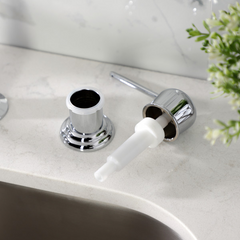
Pros and Cons of a Built In Kitchen Soap Dispenser
In the modern kitchen, where convenience, efficiency, and hygiene are paramount, innovative solutions are continuously being integrated into the culinary workspace. One such solution that has gained popularity is the built-in kitchen soap dispenser. Unlike traditional soap dispensers that sit on countertops or sinks, built-in dispensers are seamlessly incorporated into the kitchen design, offering a range of potential benefits.
Why It’s Important

The kitchen is undoubtedly the heart of the home, where delicious meals are prepared, memories are created, and families gather. Amidst the hustle and bustle of culinary activities, maintaining proper hand hygiene is of paramount importance. Effective hand washing prevents the spread of harmful bacteria, viruses, and contaminants, safeguarding the health of everyone involved. With this in mind, the integration of tools that facilitate convenient and hygienic handwashing, such as built-in kitchen soap dispensers, has gained significance. Kingston carries a variety of kitchen accessories including a wide selection of integrated soap dispensers.
Pros of a Built-In Kitchen Soap Dispenser
Featured: Restoration Faucet & Soap Dispenser
-
Less Countertop Clutter
One of the most noticeable advantages of a built-in kitchen soap dispenser is the decluttering effect it has on countertops. With a built-in dispenser, you free up valuable countertop space that can be better utilized for food preparation, storage, or other essential kitchen tasks. This streamlined setup creates an uncluttered and organized aesthetic.
-
Accessibility
Built-in soap dispensers are strategically positioned within arm's reach of the sink, making it incredibly convenient to access soap during various stages of food preparation. Whether you're handling raw ingredients, kneading dough, or marinating meats, the soap is right at your fingertips, promoting continuous hand hygiene without interrupting your cooking flow.
-
Reduce Residue
Using a built-in soap dispenser reduces the likelihood of soap residue accumulating on sink and faucet handles, which is a common issue with traditional soap bottles. This not only makes cleaning and maintenance easier but also contributes to a cleaner and more polished appearance of the sink area.
-
Ease of Use
 The convenience of a built-in dispenser encourages more frequent hand washing, as it's readily accessible and doesn't require searching for a soap bottle. This can lead to better overall hygiene practices.
The convenience of a built-in dispenser encourages more frequent hand washing, as it's readily accessible and doesn't require searching for a soap bottle. This can lead to better overall hygiene practices.-
Single-Handed Operation
Many built-in dispensers can be operated with a single hand, which is especially useful when your other hand is occupied or dirty, preventing further cross-contamination.
-
Looks & Design
Built-in soap dispensers can be tailored to seamlessly integrate with your kitchen's design and aesthetics. They come in a variety of styles, finishes, and materials to complement different kitchen themes, whether you prefer a modern, minimalist look or a more traditional ambiance. This integration adds to the overall visual harmony of the kitchen space.
-
Save Money
While the initial investment in a built-in soap dispenser might be higher compared to purchasing individual soap bottles, the long-term cost savings can be significant. Bulk refill options are often available, which reduce the cost per unit of soap, making it an economical choice over time, especially for households with high soap consumption.
-
Reduce Plastic and Single-Use Container Waste
Built-in dispensers encourage more controlled soap usage due to their calibrated dispensing mechanisms. This can lead to a reduction in the overall consumption of bottled soap, contributing to both cost savings and environmental sustainability.
Cons of a Built-In Kitchen Soap Dispenser
-
Professional Installation
Installing a built-in kitchen soap dispenser can be more complex than simply placing a traditional dispenser on the countertop.Depending on the design and model, it might require additional plumbing work, which could increase both the time and cost of installation. Homeowners may need to hire a professional plumber to ensure proper integration, which can be an inconvenience for those seeking a quick and hassle-free setup. This can add an extra layer of complexity and cost, making it a less appealing option for individuals who prefer DIY projects or want to avoid additional expenses.
-
Regular Maintenance
Built-in soap dispensers, like any other plumbing fixtures, require consistent cleaning and maintenance to prevent clogs and ensure smooth operation. Over time, soap residue and mineral deposits can accumulate within the dispenser, potentially leading to blockages that hinder proper soap flow. Regular cleaning routines are essential to keep the dispenser functioning optimally.

-
Bacteria Growth
Inadequate cleaning and maintenance can create an environment conducive to mold and bacterial growth within the dispenser, compromising the hygiene it is meant to enhance. Neglecting proper cleaning practices can lead to unpleasant odors, compromised soap quality, and potential health risks. Proper care and maintenance will help prevent this issue.
Reflect on your personal preferences and experiences. If you value the convenience of touchless operation, enhanced hygiene, and a clean, uncluttered sink area, a built-in dispenser might be a suitable choice. However, if you have specific soap preferences or prioritize low maintenance, a traditional soap bottle might be more appealing.




